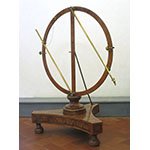This apparatus serves to study the properties of the pendulum, to compare the fall times of bodies along the chords of a given circle, and to show that the distances traveled by a falling body are proportional to the squares of the fall times. Some of these experiments had already been described by Galileo in the early decades of the seventeenth century.
The device consists of a wooden circle fastened vertically to a large triangular base of veneered wood standing on turned legs. The rim of the circle carries two brass channels. By adjusting the clamps, the channels can be positioned so as to materialize any two chords of the circle. By simultaneously releasing two identical balls into the brass channels, we observe that they consistently travel down the channels in identical time, as demonstrated by the fact that the bells at the ends of the channels ring in unison.
The instrument can also be used to demonstrate that a pendulum swung from a given height always rises back to that height even if the pendulum's length is changed during the oscillation.
The tall bar, approximately 4.5 meters long, was placed vertically along the diameter of the circle. It served to conduct experiments on free-falling bodies, demonstrating the Galilean laws of uniformly accelerated motion.
This model is more sophisticated than the one described by Jean-Antoine Nollet in Leçons de physique expérimentale (Paris, 1743-1748). Its presence in the Museo di Fisica e Storia Naturale is documented as early as 1776, indicating its provenance from the Lorraine collections.









